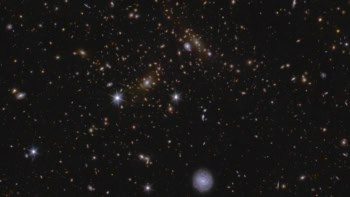
When the Sun’s magnetic output is low, winters in Europe tend to be cooler than average – whereas higher output corresponds to warmer winters. That is the conclusion of a new study by physicists in the UK and Germany that looked at the relationship between winter temperatures in England and the strength of the Sun’s magnetic emissions over the last 350 years. The group predicts that, global warming notwithstanding, Europe is likely to continue to experience cold winters for many years to come.
The possibility of a link between European winter temperatures and solar activity can be seen in historical records from the second half of the seventeenth century. For about 50 years the Sun remained free of sunspots (in contrast to its normal 11-year cycle of sunspot highs and lows) and at this time Europe experienced a number of harsh winters. Motivated by the fact that the relatively cold winters of the past few years have come at a time when solar activity fell to the lowest values for 100 years, Mike Lockwood of the University of Reading and colleagues set out to establish whether or not there is a strong connection.
Lockwood and colleagues used data from the Central England Temperature record. This provides monthly temperature data from several monitoring stations in central England all the way back to 1659 – the world’s longest instrumental temperature record. The researchers first removed the estimated contribution from the warming recorded in the northern hemisphere as a whole over the past century – which is widely believed to have been caused by increasing levels of manmade carbon dioxide in the atmosphere. Hemispheric temperature records data back to 1850; to extend the analysis back to 1659 they used data from a number of different proxy sources, such as tree rings, isotope concentrations in stalagmites, sediment depths, lake heights and documentary evidence.
Sunspot counting in the 1600s
To establish how solar activity varied over the same time period, Lockwood’s group calculated changes to the total magnetic flux carried away from the Sun by the solar wind. This they could do dating back to 1868 based on measurements of fluctuations in Earth’s magnetic field (caused by the solar changes). To extend these data back to 1659 they used a model that links solar magnetic flux levels to sunspot numbers, observations of which extend back to 1600. They did not use sunspot numbers directly because this exhibits very little variation from one minima to the next and therefore cannot be used to create a meaningful long-term trend.
Comparing the changes in English temperatures (which the researchers say are representative of European temperatures as a whole) with fluctuations in solar activity, the researchers found a strong correlation. Indeed, they say, winter temperatures are on average about a half degree centigrade lower when solar activity is low. Further analysis of the data allowed the team to conclude that the probability of the connection being a statistical fluke was less than 5%.
But what causes these changes in the Sun to modify winter temperatures, and why should this effect be limited to Europe, rather than apply to the Earth as a whole? The answer, believes Lockwood, lies in changes to the behaviour of a current of air known as a jet stream that travels west to east across the Atlantic. The jet stream can get caught up in itself and remain blocked over the ocean, preventing mild maritime winds from reaching Europe and allowing icy arctic winds to take their place. Changes in solar magnetic activity would affect the amount of ultraviolet radiation emitted by the Sun, which could then affect temperatures and wind patterns in the stratosphere, effects which, as shown by other recent research, can feed down to the troposphere – the lowest portion of the atmosphere.
According to Lockwood, lower solar activity does not guarantee a cold winter. He points out that England’s coldest winter on record was 1684 but that the following year was the third warmest on record, even though solar activity remained very low. Conversely, he adds, 1947 was a cold winter even though solar activity was high. However, he says, the results show that there are more cold winters when solar activity is low and more warm ones when it is high.
Extrapolating forward, Lockwood predicts that European winters in the coming years are likely to be colder than they have been in recent decades. He has calculated, based on evidence of past solar activity contained within cosmogenic isotope data from tree rings and ice cores, that there is an 8% chance that we will see another 50-year solar low starting within the next 50 years and that this would lower the average winter temperature in central England by half a degree.
No insight into global climate change
However, Lockwood is keen to emphasize that this research can tell us nothing about global climate change. He and his colleagues also analysed temperature data from central England in their raw state, rather than corrected for the underlying hemispheric warming trend, and found the relationship with solar activity breaks down after about 1900, when other studies show that central England temperatures began to respond to global climate change. “There is a tendency to see a local or regional effect as evidence for or against global warming,” says Lockwood. “But our work shows how one can have a regional and seasonal variation that shows solar influence but which is different from the trends in global average data.”
Michael Mann of Penn State University in the US says the research “appears to be a very solid analysis”, which “provides further support” for the idea that the Sun was behind Europe’s cold winters 300 years ago. He adds that he and other researchers have shown that fluctuations in solar activity can also explain the relatively warm winters that occurred in Europe about 1000 years ago.
The research is reported in Environmental Research Letters.




